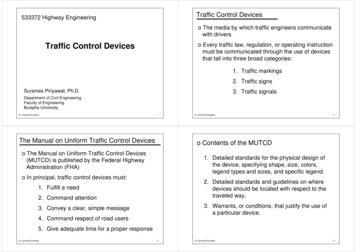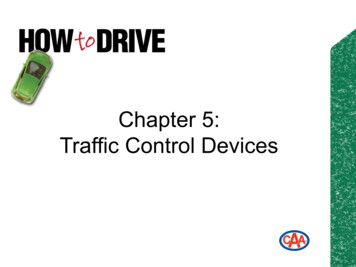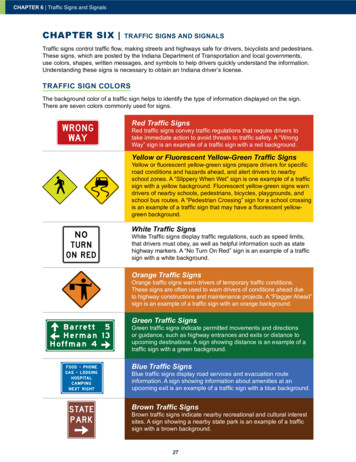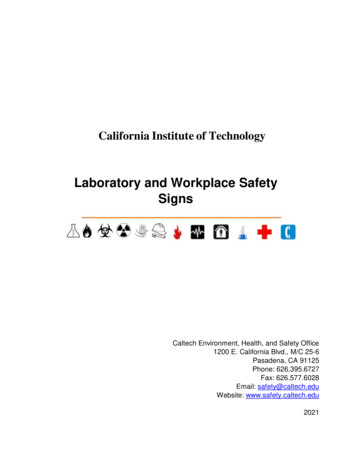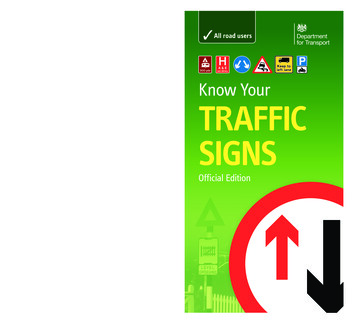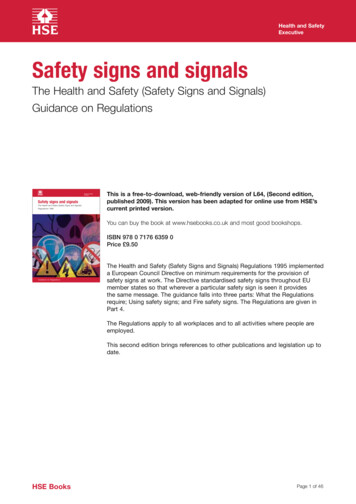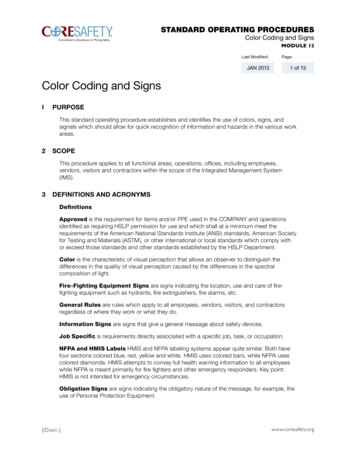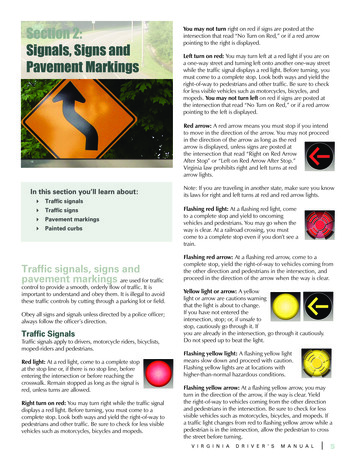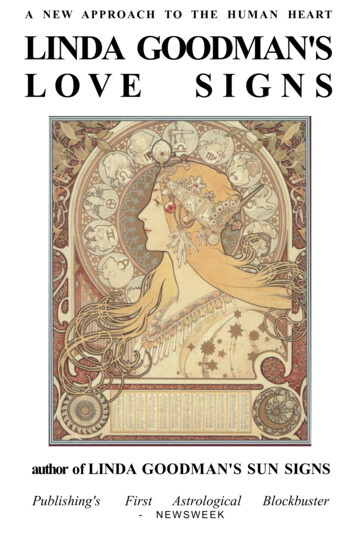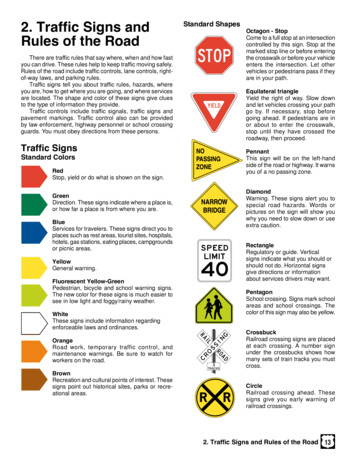
Transcription
2. Traffic Signs andRules of the RoadThere are traffic rules that say where, when and how fastyou can drive. These rules help to keep traffic moving safely.Rules of the road include traffic controls, lane controls, rightof-way laws, and parking rules.Traffic signs tell you about traffic rules, hazards, whereyou are, how to get where you are going, and where servicesare located. The shape and color of these signs give cluesto the type of information they provide.Traffic controls include traffic signals, traffic signs andpavement markings. Traffic control also can be providedby law enforcement, highway personnel or school crossingguards. You must obey directions from these persons.Traffic SignsStandard ColorsRedStop, yield or do what is shown on the sign.GreenDirection. These signs indicate where a place is,or how far a place is from where you are.BlueServices for travelers. These signs direct you toplaces such as rest areas, tourist sites, hospitals,hotels, gas sta tions, eating places, camp groundsor picnic areas.YellowGeneral warning.Fluorescent Yellow-GreenPedestrian, bicycle and school warning signs.The new color for these signs is much easier tosee in low light and foggy/rainy weather.WhiteThese signs include information regardingen forceable laws and ordinances.OrangeRoad work, temporary traffic control, andmaintenance warnings. Be sure to watch forworkers on the road.BrownRecreation and cultural points of interest. Thesesigns point out historical sites, parks or recreational areas.Standard ShapesOctagon - StopCome to a full stop at an intersectioncontrolled by this sign. Stop at themarked stop line or before enteringthe crosswalk or before your vehicleenters the intersection. Let othervehi cles or pedes trians pass if theyare in your path.Equilateral triangleYield the right of way. Slow downand let vehi cles crossing your pathgo by. If necessary, stop beforegoing ahead. If pedestri ans are inor about to enter the crosswalk,stop until they have crossed theroadway, then proceed.PennantThis sign will be on the left-handside of the road or high way. It warnsyou of a no pass ing zone.DiamondWarning. These signs alert you tospecial road hazards. Words orpictures on the sign will show youwhy you need to slow down or useextra cau tion.RectangleRegulatory or guide. Verticalsigns indicate what you should orshould not do. Horizon tal signsgive directions or informationabout services drivers may want.PentagonSchool crossing. Signs mark schoolareas and school crossings. Thecolor of this sign may also be yellow.CrossbuckRailroad crossing signs are placedat each crossing. A number signunder the crossbucks shows howmany sets of train tracks you mustcross.CircleRailroad crossing ahead. Thesesigns give you early warning ofrailroad crossings.2. Traffic Signs and Rules of the Road 13
Warning SignsThese signs are yellow with black lettering or symbols and most are diamond-shaped. These signs warn you to slow downand be prepared to stop if necessary; a special situation or hazard is ahead. Some common warning signs are shown below.Intersection/CrossroadThere is another roadahead that crosses theroad you are on. Watchcarefully for crosstraffic in your path.Merge LeftTwo lanes of trafficwill soon be come onelane of traffic. Rightlane traffic must yieldwhen merging.Gradual Right CurveRoad ahead curvesgradually to the right.Be prepared for thechange in direction.Signal AheadThese signs are usedon roads with higherspeeds. Be ready foran intersection and astop light.Farm MachineryFarm equipment may becrossing the road. Beready to slow down forslow-moving equipment.Slippery When WetRoad ahead becomesslippery in wet weather.Slow down under theseconditions.Merging TrafficPedestrian CrossingIf you are on the mainWatch out for peopleroad and see this sign,who might walk or runbe prepared for otherin front of your vehicle.vehicles blending intoyour lane.Chevron SignUsed in addition to thecurve signs when there isa need to draw addedattention to a change inthe road’s direction.Two-Way TrafficKeep to the rightbecause you are leavinga one-way road andentering a two-way road.Deer CrossingThere may be deer tryingto cross the roadway inthe area. Slow down andwatch carefully.Ramp SpeedThe recommended speedon an exit ramp.Divided Highway BeginsYou are getting close tothe place where two-waytraffic will be dividedby a center strip.HillThis sign is a warning toall vehicles that the roadahead goes down a hill.You should check yourbrakes before goingdown the hill.Advance School CrossingYou are nearing a schoolarea with a crossing.Watch for children and themarked school crossing.The color of this sign maybe yellow.Divided Highway EndsT-Intersection AheadTwo-way traffic will noThe road you are on doeslonger be divided by anot go straight ahead.center strip. Watch outPrepare to turn right orfor oncoming vehicles.left.Horse-drawn VehicleBe alert for slow-moving,horse-drawn vehicleson the roadway. Reduceyour speed and pass slowly.14 2. Traffic Signs and Rules of the RoadSchool Bus Stop AheadWatch for children.Be prepared to stop. Youare nearing an area wherea stopped school bus willpick up or dischargepassengers.School CrossingWatch for children.Reduce speed. Obeycrossing guard signalsLook out for childrenplaying. The color of thissign may also be yellow.
Regulation SignsThese signs give you information about rules for trafficdirection, lane use, turning, speed, parking and other specialsituations.Some regulation signs have a red circle with a red slashover a symbol. Theseindicate you cannotdo something; for example, no left turn, noright turn, or no U-turn.Speed Limit SignsThese signs indicate the maximum orminimum safe speed that is allowed. Themaximum limits are for ideal conditions andyou must reduce your speed when conditionsrequire it, such as when the roadway is slippery (during rain) or it is difficult to see clearlydown the road (during fog). Some high speedroads have minimum speed limits. If this mini mum speed istoo fast for you, then you should use another route.Lane Control SignsThese signsmark whereyou can go andwhere you canturn, and oftenuse an arrow symbol. The signs are along the road or hangingover the road. Sometimes arrows may be painted on the road.Passing SignsThese signs mark where it may be safe to pass anothervehicle and where you cannot.Passing areas are based on howfar you can see ahead. Theyconsider unseen hazards such asintersections, driveways and otherplaces a vehicle may enter the roadway. The signs indicatewhere you may pass, or the beginning and ending of apassing zone, or where you may not pass. Where passingis allowed, you may do so only if it is safe.Stop SignA stop sign is red, with white letters, andhas eight sides. It means you must come to afull stop. You must wait until crossing vehi clesand pedestrians have cleared. You must stopat the stop line if one is present. If necessary,you may then pull forward to the stop sign orthe edge of the inter sec tion and then proceed when it issafe to do so.Yield SignA yield sign is shaped like a downwardpoint ing trian gle. It is red and white with redletters. It means you must slow down and yieldthe right of way to traf fic in the intersec tion youare crossing or road way you are entering.Divided HighwayThe road ahead is divided. This signdirects traffic to the right of an island orbarrier.Wrong WayYou made a wrong turn and haveentered a lane of oncoming traffic. Getout the safest and quickest way possible.One WayTraffic moves only in the directionof the arrow.Do Not Enter SignA square sign with a white horizontalline inside a red circle means you cannotenter. You will see this sign at roadwayopenings you are not to enter and whentraffic is one way against you. You willsee them at exit ramps, in crossoverson divided roadways, and at numerousloca tions on one-way roads.Slow-MovingVehicle SignA reflective orange triangle on the rearof a vehi cle means it is traveling 35 mph orless. You may see this sign on road workequip ment, farm vehi cles, or horse-drawnwag ons or car riages. It shows up as a solidorange triangle by day and a hollow redtriangle at night.Guide SignsThese signs are squareor rectangular shaped, andare green or brown withwhite lettering. They showdirections and distance tovarious locations, or areassuch as cities, air ports, statelines; or to special areas such asnational parks, historical areas or museums.30Service SignsThese signs are square or rectangularshaped, and are blue with white let ters orsymbols. They show the location of variousservices; such as rest areas, gas stations,campgrounds or hospitals.2. Traffic Signs and Rules of the Road 15
Route SignsLeft-Turn Signal HeadThe shape ofroute signs indicatethe type of road way, interstate, U.S.,s t a t e , o r c o u n t y.When plan ning a trip, use a highway map to determine yourroute. During the trip, follow the route signs. This will helpyou stay on your route.Traffic SignalsRedCome to a complete stop at thestop line or before entering theintersec tion.YellowDo not enter the intersec tionif you can stop safely. If youcannot stop safely, proceedthrough the inter s ectionwith caution. A yellow lightwarns pedes trians there isnot enough time to cross thestreet. Any one crossing thestreet on a yellow light shallyield the right-of-way to allvehi cles.GreenGo, but only when the intersection is clear. You mustyield to vehicles and pedestri ans in the intersection. Whenthe light changes, traffic may be caught in the intersec tion.You must give them the right of way while they clear theintersec tion.Yellow ArrowDo not enter the intersection if you can stop safely. If youcannot stop safely, proceed only in the direction of thearrow.The new left-turn signal headhas four signals.Steady Red ArrowDrivers turning left must stopand wait.Steady Yellow ArrowThe left-turn signal is aboutto turn red. Do not enter theintersection if you can stopsafely. Complete your left turnif you are already within theintersection.Flashing Yellow ArrowYield to oncoming traffic andpedestrians; then turn leftproceeding with caution. Oncoming traffic has a greenlight.Steady Green ArrowDrivers can proceed with the left turn. Oncoming trafficmust stop. Do not go straight.Railroad Crossings Motorists must use extra caution at railroad crossings. Trains cannot stop quickly. Never try to beat a train across the tracks. Even if itis a tie, you will be the loser. It is not wise to shift gears when crossing railroadtracks; you might stall. Never stop your vehicle on the railroad tracks.Advance warning signs and pavement markingsindicate railroad tracks cross the road ahead. Be prepared tostop before you get to the tracks if a train is approach ing thecrossing. Pave ment markings are a large “X” with the letters“RR” on the road. These marks are not used at all cross ings.Green ArrowDrive only in the direction of the arrow. Yield the right of wayto other vehicles and pedestri ans already in the intersec tion.Railroad/highway/side road intersectionFlashing RedTreat it the same as a stop sign.Flashing YellowProceed with caution. Yield to vehicles andpedestrians, and proceed when it is safe.16 2. Traffic Signs and Rules of the RoadCrossbuck signs have been put at many public railroadcrossings. This sign means look both ways, listen for and yieldto trains. A number sign under the crossbuck indicates thereis more than one set of tracks following the sign.
Flashing light signals may be used withcrossbucks. Stop when the lights are flashing. Do not cross until you can do it safely.If there is more than one track, be carefulto watch for trains from either the same oropposite direc tion.Gates are used with flashing lights atsome crossings. Stop when the lights startto flash before the gate goes down. Remainstopped until the gates go up and the lightsstop flashing. Never drive around the gates.It is dangerous and against the law.Railroad gates and warning lights areto alert you that a train is in the area. Youmay collide with a train if you go onto thetracks.It is against the law to pass any vehiclewithin 100 feet of a railroad crossing.Required StopsAll school buses and vehicles carryingpassengers for hire, and all vehicles requiredto be placarded for hazardous materials,must stop within 15 to 50 feet of railroadtracks before crossing. If a police officer orhighway traffic signal directs highway traffic toproceed, you do nothave to stop. Youalso do not have tostop if the crossingis marked with an“EXEMPT” sign.Road Work ZonesThese traffic control devices andsigns are used to mark construc tion,maintenance, survey and utility workzones. These help direct drivers andpedestrians safely through the workarea while keeping it safe for workerson the highway. Stay alert and drivecautiously as fines may double inwork area zones.The most commonly used traffic control devices are signs,barri cades, vertical panels, drums, cones, tubular markers,flashing arrow panels and flaggers. Most signs in work areasare diamond-shaped, although a few signs are rectangular.Orange is the basic color of these signs and warning devices.These signs and traffic con trol devices are reflectorized toattract your atten tion at night.Slanting stripes on a panel or barri cade tell you on whichside to pass. Stripes sloping down to the right mean passon the right. Stripes slop ing down to the left mean pass onthe left.You may encounter road work zones throughout theyear which can be a danger to motorists and road workersalike due to careless or inattentive drivers. In work zones,remember these tips: Adjust your speed to the traffic conditions. Obey all instructions provided by signs, traffic signalsand flaggers. Don’t follow other vehicles too closely. Always “Expect the unexpected in ‘The Work Zone.’”Flashing Arrow PanelsLarge flashing arrow panels maybe used in work areas to direct drivers into certain traffic lanes. Thesepanels also alert you that part of theroadway is closed to traffic.FlaggersPeople with stop/slowpaddles help control trafficin work zones. Fol low theirinstructions. They should bewearing lime green or orangevests, shirts or jackets. Theywill normally use stop/slowsigns. Red flags may be nelizing DevicesBarricades, vertical panels, drums, cones and tubularmarkers are the most commonly used devices to alertdrivers of unusual or potentially dangerous condi tionsin highway and street workareas, and to guide driverssafely through the work zone.Flashing lights are used toalert motorists of a hazard.TubeDrumBarricadePavement Markingsand Other Lane ControlsPavement markingshelp direct and regulatetraffic, just like highwaysigns. You will find themalone or used with signsand traffic signals. Whitelines separate trafficmoving in the samedirection. Yellow linesseparate traffic movingin opposite directions.On two-way roads you will see a solid yellow line with abroken line beside it in some places. Passing is not allowedon the side with the solid yellow line. Vehicles on the sidewith the broken line may pass when the way is clear.At intersections, special arrow markings or heavy whitelines give you directions or mark off pedestrian crosswalks.2. Traffic Signs and Rules of the Road 17
Crosswalks, Stop Lines andDirec tional Arrow Mark ingsWhen required to stopbecause of a sign or signal,you must stop before yourvehicle reaches the stopline, or a crosswalk if thereis one. Cross walks definethe area where pedes triansare to cross the road way.You must yield to pedes tri ans in or about to entera cross walk. Not all crosswalks are marked. Be alertfor pedestrians when cross ing intersec tions that do nothave de fined crosswalks.Spe c ial arrow markingsmay be pres ent.Reversible LanesSome travel lanes are designed tocarry traffic in one direction at certaintimes and in the opposite direction atother times. These lanes are usuallymarked by double-dashed yellow lines.Before you start driving in them, checkto see which lanes you can use at thattime. There may be signs post ed by theside of the road or overhead. Sometimesspecial lights are used. A green arrowmeans you can use the lane beneath it;a red “X” means you may not. A flashing yellow “X” means the lane is onlyfor turning. A steady yellow “X” meansthat the use of the lane is changing andyou should move out of it as soon as itis safe to do so.Shared Center Lanefor traffic coming from the other direction. These lanes aremarked on each side by a solid yellow and dashed yellowlines.General Lane Use Do not back a vehicle in a travel lane. It is unsafe todo so. Drivers do not expect a vehicle to be backingtowards them and may not realize it until it is too late.If you miss your turn or exit, do not back up on thetravel lane or shoulder. Continue to travel to the nextexit or crossroad. Do not stop in travel lanes for any reason (confusion,breakdown, letting out a passenger). Keep movinguntil you can safely pull off the road. On a road with three or more lanes traveling in thesame direc tion, stay in the right lane except to pass.If there is a lot of entering traffic, then use the centertravel lane. Unless instructed to do so by a traffic control deviceor a flagger, never drive on the shoulder of the road. On multi-lane roads, the left-most lane is intended tobe used to pass slower vehicles. If you pass on theright, the other driver may have difficulty seeing youand might suddenly change lanes in front of you. Neverpass on the shoulder, whether it is paved or not. Otherdrivers will never expect you to be there and may pulloff the road without looking. Where there are no signs or lane markings to controlturning, you should turn from the lane that is closestto the direction you want to go, and turn into the laneclosest to the one you came from. When making turns, go from one lane to the otheras directly as possible without crossing lane lines orinterfering with traffic. Once you have completed yourturn, you can change to another lane if you need to.Reserved LanesOn various roadways one or more lanes may be reservedfor special vehicles. Reserved lanes are marked by signsstating that the lane is reserved for special use, and oftenhave a white diamond posted at the side of the road and/orpainted on the road surface. Do not travel in one of theselanes unless operating that type of vehicle.(Left) This sign means the lane is for busand car pool use only.(Right) This sign means the lane is reserved for bicyclists.These center lanes are reserved for making left turns (orU-turns when they are permitted) but can be used by vehiclestraveling in both directions. On the pavement, left-turn arrowsfor traffic in one direction alternate with left-hand arrows18 2. Traffic Signs and Rules of the RoadHigh Occupancy Vehicles (HOV) lanes arereserved for car pools and vehicles with morethan one person in them. Signs say how manypeople must be in the vehicle as well as thedays and hours to which it applies. For example, “HOV 4” means there must be at leastfour people in the vehicle.
When to Yield the Right-of-WayIntersectionsThe following right-of-way rules apply at intersections: You must yield when you want to make a right turnafter stopping at a red light, but before the light turnsgreen. However, turns on red must be permitted atthat intersection. Drivers crossing a sidewalk entering or exiting a driveway, alley, or parking lot must yield to pedestri ans. Itis illegal to drive on a sidewalk except to cross it. Pedestrians using a guide dog or carrying a white canehave absolute right-of-way. Do not use your horn as itcould confuse or frighten the pedestrian who is blind. Drivers turning left must yield to oncoming cars thatare going straight ahead. You should watch out for bicyclists. Be ready to yieldthe right-of-way, even at times the bicyclists shouldyield to you. They have no defense against a car ortruck, so it is your responsibility as a driver to watchout for them. At an intersection where there is no stop sign or trafficsignal, drivers must yield to vehicles coming from theright. At a four-way stop, the driver reaching the intersectionfirst gets to go first (after coming to a complete stop). Drivers entering a road from a driveway, alley or roadside must yield to vehicles already on the main road. You must yield or stop for pedestrians in marked crosswalks, and at unmarked crosswalks at intersections. You should yield to other vehicles when approachingthe triangular shaped “yield” signs.POLICEWhere vehicles or pedestrians are likely to meet oneanother and there are no signs or signals to regulate traffic, there are rules that say who must yield the right-of-way.These rules tell drivers who goes first and who must wait indifferent traffic situations.The law says who must yield the right-of-way; it doesnot give anyone the right-of-way. You must do everythingyou can to prevent striking a pedestrian or another vehicle,regardless of the circumstances.Be alert for bicyclists. While bicyclists and motorists mustshare the rights and responsibilities of using public streetsand roads, motorists should realize bicycle riders are veryvulnerable in crashes. Therefore, motor vehicle driversshould use good defensive driving skills to avoid collisionswith bicyclists.vehicle’s loudspeaker. If youare in an intersection, drivethrough theintersectionbefore you pullover. However,if you are on astreet or high way separatedby a medianstrip and theemergency vehicle is on theother side, you do not have to stop. You must stay at least500 feet behind any emergency vehicle using lights andsirens on its way to an emergency.Persons who are BlindIf you approach aperson walking with awhite cane or a whitecane tipped with red,you must stop andtake whatever action is necessary toprevent injury to thatperson. The sameapplies to a personbeing led by a guidedog which is wearinga harness and walkingby or in front of the person.Yielding Situations(red car shown here must yield to approaching vehicle)Car in intersectionCar on rightOncoming trafficAt yield signOvertaking VehiclesDrivers overtaking a vehicle traveling in the same direction must yield to that vehicle and allow the vehicle full useof the lane.Emergency VehiclesYou must yield the right-of-way to a police vehicle, fireengine, ambulance or other emergency vehicle using a sirenor air horn, and a red or blue flashing light. Pull over to theright edge of the road, or as near to the right as possible, whenyou see or hear an emergency vehicle approaching from anydirection. Follow any instructions given over the emergency2. Traffic Signs and Rules of the Road 19
School BusesWhen you meet an oncoming school bus displaying flashing amber lights, you must slow down to no more than 20mph and be prepared to stop. If the red lights are flashing orif the stop arm is out, you must come to a complete stop atleast 15 feet from the bus. You must remain stopped as longas the red lights flash or the stop arm is out.The only exception to this is where you are approachingthe bus from the opposite direction on a road with at leasttwo lanes in each direction.When overtaking a school bus, you may not pass whenred or amber warning lights are flashing.After a school bus has stopped to let students off, watchfor children on the side of the road. If you are headed uphill, turn your front wheels awayfrom the curb. Then let the car roll back slightly untilthe right front tire hits the curb. If you are parkinguphill and there is no curb, turn your front wheelstoward the side of the road. That way, the vehiclewill roll away from traffic if it moves.Down hill(with or without curb)Up hill with curbParking Is Not AllowedIf the red lights are flashing or if the stop arm is out, you mustcome to a complete stop at least 15 feet from the bus andremain stopped as long as the red lights flash or the stop armis out.ParkingDrivers are responsible for making sure their vehicles donot become a hazard after they have been parked. Wheneveryou park your car, follow these guidelines. Park far enough from any travel lane to avoid interfering with traffic. Make sure your car is visible to drivers approach ingfrom either direction. Park in a designated area, if possible. Always set your parking brake when you park. Leavethe vehicle in gear if it has a manual transmission,or in “park” if it has an automatic transmission. Check traffic before you open the door. Get out ofthe vehicle on the curb side if you can. If you haveto use the street side, check traffic before you getout. Shut the door as soon as you can after gettingout. Never leave the ignition keys in a parked car. Lockthe doors whenever you leave your vehicle if it willbe out of your sight at any time. If you must park on a roadway, park your vehicle asfar away from traffic as possible. If there is a curb,park as close to it as you can. When you park headed downhill, turn your frontwheels toward the curb or roadside so the vehiclewill roll away from traffic if it moves.20 2. Traffic Signs and Rules of the RoadUp hill without curbThere are many areas where you cannot park. Check forsigns that may prohibit or limit parking. Some parking restrictions are indicated by colored curb markings. Do not park: on a crosswalk; in front of a public or private driveway; on any bridge outside city limits or in highway tun nels; alongside another stopped or parked car (doublepark ing); closer than five feet from a fire hydrant; closer than 10 feet from a stop sign; closer than 20 feet from a fire station entrance; closer than 50 feet from a hotel or theater entrance; closer than 50 feet from a railroad crossing; closer than eight feet parallel to a railroad crossing; in “NO PARKING ZONES” which are usually markedwith signs or yellow painted curbs; in an intersection; or on a sidewalk.
Parallel Parking Signal and stop withthe rear bump e r ofyour vehi c le evenwith the rear bumper of the vehicle infront of the place youwant to park. The twovehicles should beabout one to two feetapart. Turning your steeringwheel to the right,back slowly aimingthe back of your cartowards the front ofthe car behind you.cident if your emergen cy or parking brake fails.To leave a parallel parking space, signal your move. Watchfor traffic and turn your steering wheel towards the open lane,easing your way into traffic.If you park on a road outside city limits, you must makesure you are completely off the pave ment. In all cases, policeare authorized to remove illegally parked vehicles.Approaching Stationary VehiclesWhen approaching a stationary vehicle such as a policecar, tow truck, utility or maintenance, garbage/recycling collection, construction vehicle, or any vehicle that is parkedalong side the road and displaying flashing lights or standardhazard lights, you are required to make a lane change. Youmust make the lane change only if it is safe to do so according to road and traffic conditions.If a lane change is not possible, prohibited by law, orunsafe, you must slow down to a reasonable and properspeed for the existing conditions and be prepared to stop.Cell Phones and Texting WhileDriving As the front of yourcar clears the backof the car in front ofyou, turn your wheelssharply to the leftand continue backingslowly until the backof your car almosttouches the car be hind you. Straighten yourwheels and pull forward to center the carin the parking space.Your car should be nomore than 18 inchesfrom the curb. Putthe trans mission inpark if your car hasan automat ic transmission and set thebrake. Turn off theengine. (It is againstthe law to leave keys in a run ning, unat tended vehicle.)It is highly dangerous to divide your attention from the taskof driving by using cells phones, text messaging devices andelectronic entertainment devices.It is unlawful for any driver in Iowa to read, write or senda text message while driving. Before using a hand-held electronic communication device to write, send, or read a textmessage, the vehicle must be brought to a complete stop offthe traveled portion of the roadway. Exceptions to reading atext message are limited to: A member of a public safety agency performingofficial duties A health care professional in the course of anemergency situation A person receiving safety-related informationincluding emergency, traffic, or weather alerts.It is unlawful for persons under the age of eighteen operating a motor vehicle with a Minor Restricted License, Instruction Permit, Intermediate License, or Minor School Licenseto use an electronic communication device (including cellphones) or an electronic entertainment device unless themotor vehicle is at a complete stop off the traveled portionof the roadway.It is unlawful for a person to text or use a handheld mobile device while driving a commercial motor vehicle, if theperson is required to have a commercial learner’s permit orcommercial driver’s license to operate the vehicle.To park by the left-hand curb on a one-way street, followthe same directions but reverse right and left in the instructions.If your car has a manual transmission, leave it in low gearwhen parked and headed uphill. Leave it in reverse whenparked and headed downhill. This will help prevent an ac-2. Traffic Signs and Rules of the Road 21
Notes22
Octagon - Stop Come to a full stop at an intersection controlled by this sign. Stop at the marked stop line or before entering the crosswalk or before your vehicle enters the intersection. Let other vehi cles or pedes trians pass if they are in your path. Equilateral triangle Yield the right of way. Slow down and let vehicles crossing your path
